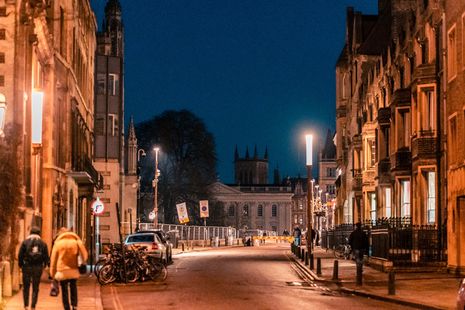After Hours and the art of a Cambridge night out
Elspeth White explores the fever-dream nights out of Scorcese’s After Hours and Cambridge

Martin Scorcese’s After Hours (1985) is a nightmare. Part black comedy, part panic attack, After Hours sees white-collar worker Paul Hackett descend into the madness that is New York City at night, in the pursuit of – well, we never really know what. An encounter with manic-dream-esoteric-novel-reading Marcy in a diner triggers a series of surreal encounters that wind around claustrophobic city streets, until they eventually give way.
"It is this anxiety and urgency that speaks to the experience of living in Cambridge"
The Cambridge bubble and Scorcese’s seedy, neon New York are at first glance different beasts. But as soon as the night falls, they are both as menacing, camp and surreal as each other. The world of After Hours is a rainy SoHo that doesn’t sprawl but folds in on itself, with spaces and people connecting in bizarre ways, much like the small world of central Cambridge. Paul Hackett, who races to escape this world, wraps himself in circles, taunted by the ever-louder ticking of a clock (or bomb) that dominates the soundtrack. It is this anxiety and urgency that speaks to the experience of living in Cambridge.
Yet, within this claustrophobia, After Hours manages to find the uncanny, the empty and the dreamlike. We track empty midnight diners, dive-bars, 60s capsule apartments, bohemian loft studios, and nightclubs. This pairs with bizarre images (mohawks and paper-maché people are two stand outs) and an eclectic soundtrack (from Joni Mitchell to Mozart). With all this, Scorcese launches us into a landscape that is just as reminiscent of a fever dream as an 80s satire, taking notes from David Lynch’s seedy dreamscape filmography.
)
What can Good Will Hunting teach us now? | Varsity
Once Cambridge’s cobbled paths un-clog themselves, they too transform into the space of dreams, nightmares - or something between the two. You may find yourself stumbling home, giggling, as looming stone buildings watch you with a stern seven-hundred-year-old glare. A cigarette in one hand and a Red Bull in the other, a group of ghostly figures cross the road in front of you: this is not a cult ritual, simply what happens after a formal.
"The monotony that he attempts to escape from, that we attempt to escape from"
Later, you stumble into a club, only to find that it is empty. In After Hours, Hackett finds himself in this position, and slow dances with the club’s only client, a mysteriously-aged woman. Peggy Lee’s voice whispers over the uncomfortable scene: “is that all there is?” This is both an anti-climax and exactly what you expect to find in Hours and the clubs of Cambridge.
Our city and Scorcese’s New York are full of characters who are unabashedly weird. Scorcese revels in the uncomfortable, the marginal and the cartoonish. Beyond the silent woman in the nightclub, we see openly queer characters, thieves, fanatics and leather-clad couples. While perhaps Cambridge lacks this edge, what it does not lack is people unafraid to embrace the bizarre and the authentic, as they too try to navigate this fever-dream of a place. These are people trying to distract themselves from what the day holds. After Hours opens in the hours ‘before’: that is to say, office hours. Paul Hackett works in a beige office, in a beige suit, at a beige desk – this is the monotony that he attempts to escape from, that we attempt to escape from.
"After Hours is an ideal watch for Cambridge students"
After Hours is not a forgiving portrait of work and the search for meaning in our day-to-day lives. Knowing the persistence of academic workload and how this is built into the Cambridge landscape, we might be tempted to give into the film’s nihilist message and let our sleep-deprived madness take hold. But I would argue After Hours is an ideal watch for Cambridge students for exactly these reasons. After Hours is cathartic. It is stressful and dark and funny and uncomfortable, with characters who are in equal part mysterious and unlikeable. It might hit close to home, but it will ultimately veer us away into a surreal world, a testing ground for our most outlandish ideas and encounters in this bizarre city.
 News / Eight Cambridge researchers awarded €17m in ERC research grants27 December 2025
News / Eight Cambridge researchers awarded €17m in ERC research grants27 December 2025 News / News in Brief: carols, card games, and canine calamities28 December 2025
News / News in Brief: carols, card games, and canine calamities28 December 2025 News / Caius mourns its tree-mendous loss23 December 2025
News / Caius mourns its tree-mendous loss23 December 2025 News / Clare Hall spent over £500k opposing busway 24 December 2025
News / Clare Hall spent over £500k opposing busway 24 December 2025 Interviews / Meet Juan Michel, Cambridge’s multilingual musician29 December 2025
Interviews / Meet Juan Michel, Cambridge’s multilingual musician29 December 2025








